The Impact of Parkinson's Disease: A Patient Interview and Analysis
VerifiedAdded on 2022/08/20
|8
|2240
|12
Essay
AI Summary
This essay presents a patient interview conducted with a 61-year-old semi-retired individual named Jack, diagnosed with Parkinson's disease (PD). The essay explores the impact of PD on Jack's life and his family, analyzing his medical history, symptoms, and the challenges he faces, including tremors, fatigue, memory loss, and gait instability. Utilizing the Roper, Logan & Tierney model and the Levitt-Jones clinical reasoning cycle, the essay identifies key areas of need, such as impaired self-care abilities and potential medication interactions, and establishes two primary care priorities: addressing self-care deficits and managing medication to prevent complications. The essay emphasizes the importance of a patient-centered approach, aiming to improve Jack's quality of life by focusing on autonomy, nutrition, fall prevention, and effective medication management, ultimately highlighting the significance of nursing care in managing chronic diseases like Parkinson's.
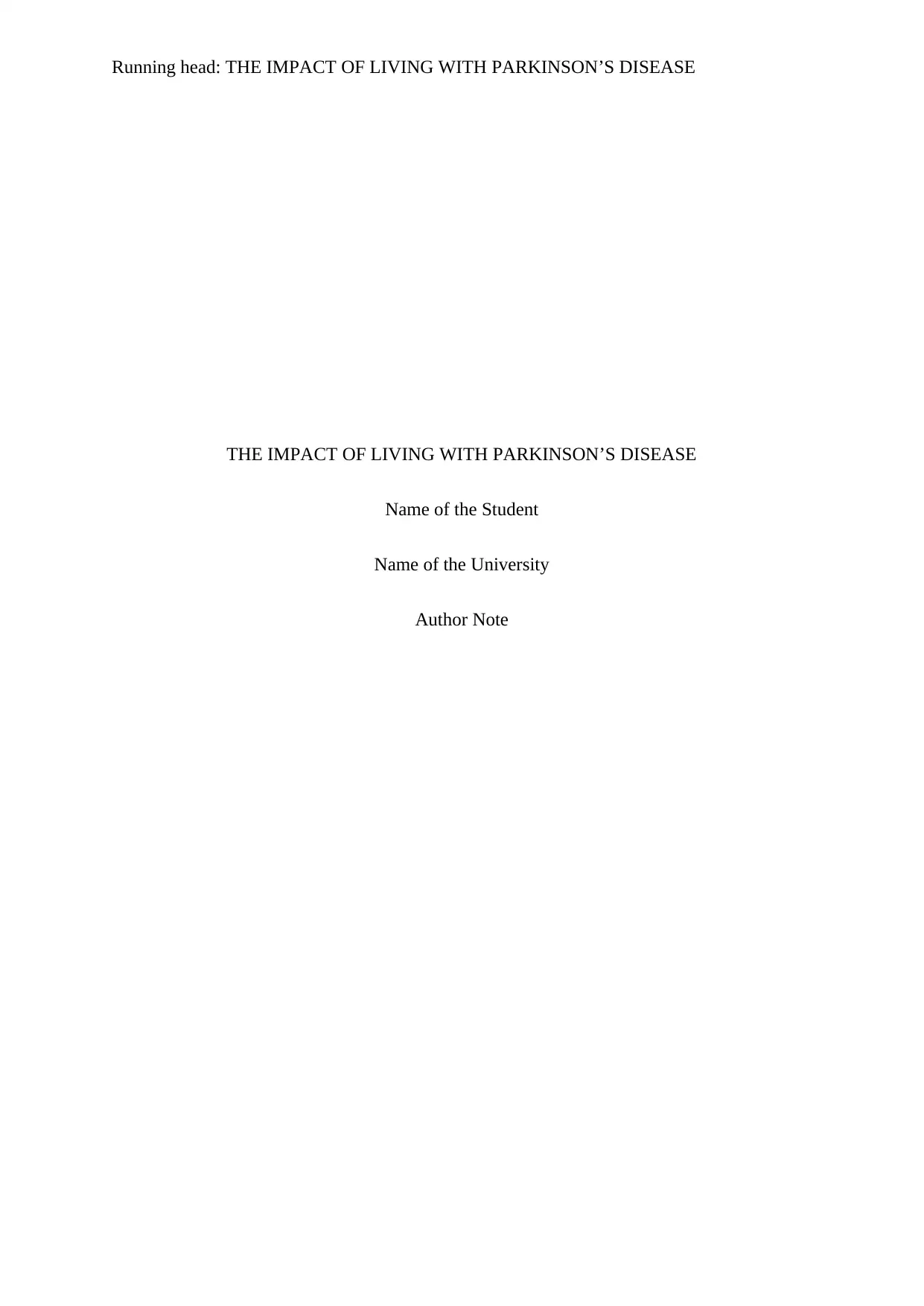
Running head: THE IMPACT OF LIVING WITH PARKINSON’S DISEASE
THE IMPACT OF LIVING WITH PARKINSON’S DISEASE
Name of the Student
Name of the University
Author Note
THE IMPACT OF LIVING WITH PARKINSON’S DISEASE
Name of the Student
Name of the University
Author Note
Paraphrase This Document
Need a fresh take? Get an instant paraphrase of this document with our AI Paraphraser
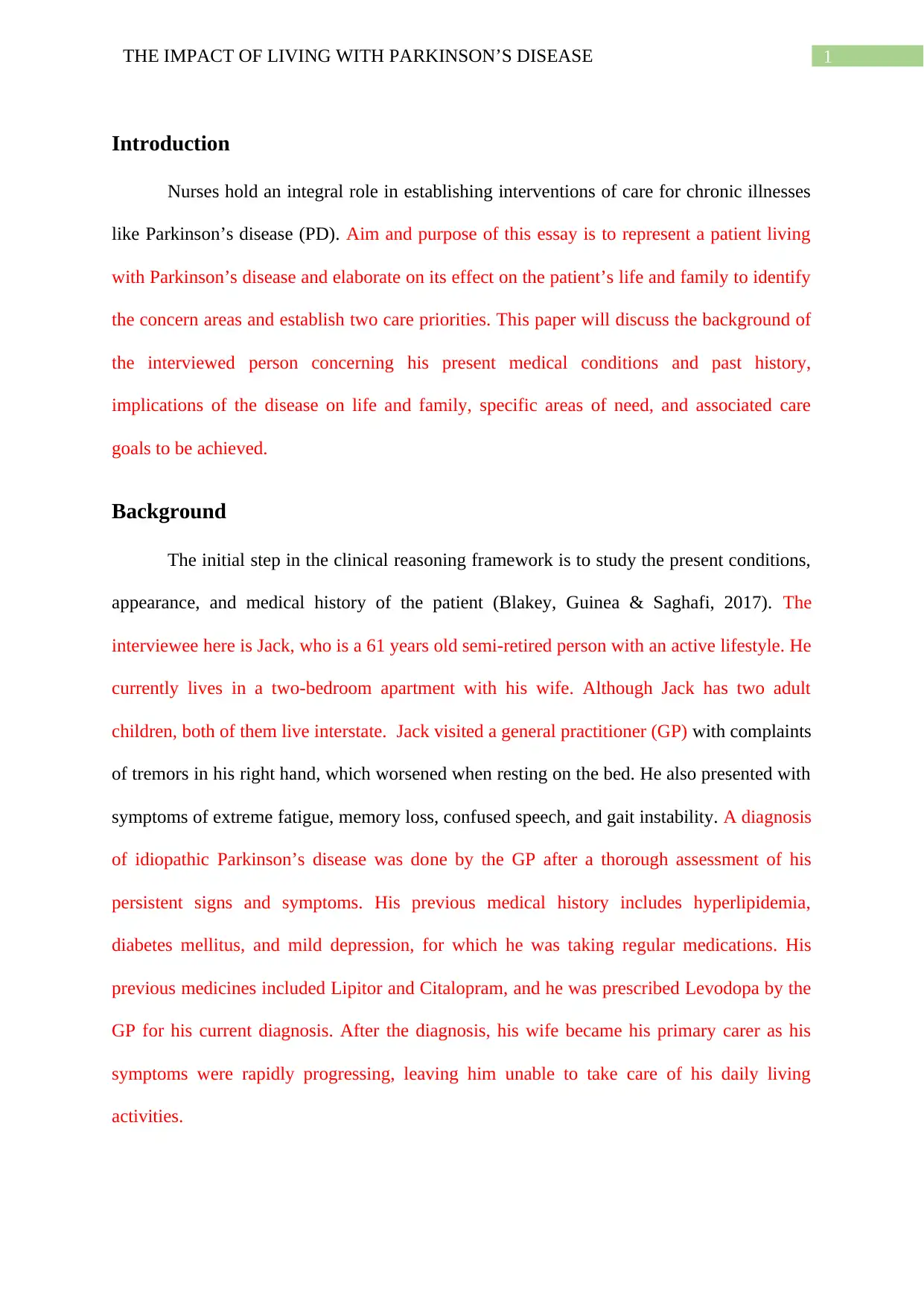
1THE IMPACT OF LIVING WITH PARKINSON’S DISEASE
Introduction
Nurses hold an integral role in establishing interventions of care for chronic illnesses
like Parkinson’s disease (PD). Aim and purpose of this essay is to represent a patient living
with Parkinson’s disease and elaborate on its effect on the patient’s life and family to identify
the concern areas and establish two care priorities. This paper will discuss the background of
the interviewed person concerning his present medical conditions and past history,
implications of the disease on life and family, specific areas of need, and associated care
goals to be achieved.
Background
The initial step in the clinical reasoning framework is to study the present conditions,
appearance, and medical history of the patient (Blakey, Guinea & Saghafi, 2017). The
interviewee here is Jack, who is a 61 years old semi-retired person with an active lifestyle. He
currently lives in a two-bedroom apartment with his wife. Although Jack has two adult
children, both of them live interstate. Jack visited a general practitioner (GP) with complaints
of tremors in his right hand, which worsened when resting on the bed. He also presented with
symptoms of extreme fatigue, memory loss, confused speech, and gait instability. A diagnosis
of idiopathic Parkinson’s disease was done by the GP after a thorough assessment of his
persistent signs and symptoms. His previous medical history includes hyperlipidemia,
diabetes mellitus, and mild depression, for which he was taking regular medications. His
previous medicines included Lipitor and Citalopram, and he was prescribed Levodopa by the
GP for his current diagnosis. After the diagnosis, his wife became his primary carer as his
symptoms were rapidly progressing, leaving him unable to take care of his daily living
activities.
Introduction
Nurses hold an integral role in establishing interventions of care for chronic illnesses
like Parkinson’s disease (PD). Aim and purpose of this essay is to represent a patient living
with Parkinson’s disease and elaborate on its effect on the patient’s life and family to identify
the concern areas and establish two care priorities. This paper will discuss the background of
the interviewed person concerning his present medical conditions and past history,
implications of the disease on life and family, specific areas of need, and associated care
goals to be achieved.
Background
The initial step in the clinical reasoning framework is to study the present conditions,
appearance, and medical history of the patient (Blakey, Guinea & Saghafi, 2017). The
interviewee here is Jack, who is a 61 years old semi-retired person with an active lifestyle. He
currently lives in a two-bedroom apartment with his wife. Although Jack has two adult
children, both of them live interstate. Jack visited a general practitioner (GP) with complaints
of tremors in his right hand, which worsened when resting on the bed. He also presented with
symptoms of extreme fatigue, memory loss, confused speech, and gait instability. A diagnosis
of idiopathic Parkinson’s disease was done by the GP after a thorough assessment of his
persistent signs and symptoms. His previous medical history includes hyperlipidemia,
diabetes mellitus, and mild depression, for which he was taking regular medications. His
previous medicines included Lipitor and Citalopram, and he was prescribed Levodopa by the
GP for his current diagnosis. After the diagnosis, his wife became his primary carer as his
symptoms were rapidly progressing, leaving him unable to take care of his daily living
activities.
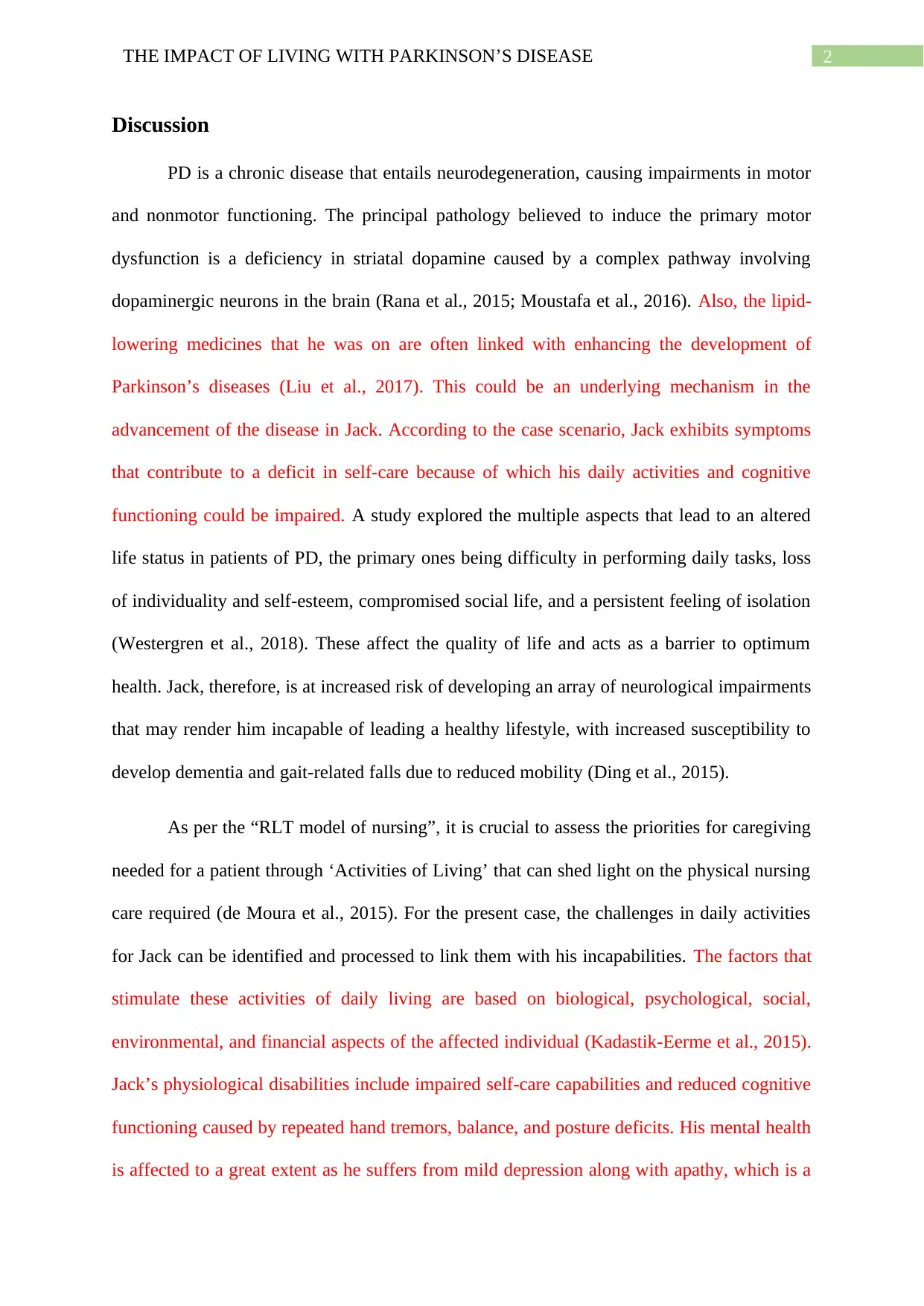
2THE IMPACT OF LIVING WITH PARKINSON’S DISEASE
Discussion
PD is a chronic disease that entails neurodegeneration, causing impairments in motor
and nonmotor functioning. The principal pathology believed to induce the primary motor
dysfunction is a deficiency in striatal dopamine caused by a complex pathway involving
dopaminergic neurons in the brain (Rana et al., 2015; Moustafa et al., 2016). Also, the lipid-
lowering medicines that he was on are often linked with enhancing the development of
Parkinson’s diseases (Liu et al., 2017). This could be an underlying mechanism in the
advancement of the disease in Jack. According to the case scenario, Jack exhibits symptoms
that contribute to a deficit in self-care because of which his daily activities and cognitive
functioning could be impaired. A study explored the multiple aspects that lead to an altered
life status in patients of PD, the primary ones being difficulty in performing daily tasks, loss
of individuality and self-esteem, compromised social life, and a persistent feeling of isolation
(Westergren et al., 2018). These affect the quality of life and acts as a barrier to optimum
health. Jack, therefore, is at increased risk of developing an array of neurological impairments
that may render him incapable of leading a healthy lifestyle, with increased susceptibility to
develop dementia and gait-related falls due to reduced mobility (Ding et al., 2015).
As per the “RLT model of nursing”, it is crucial to assess the priorities for caregiving
needed for a patient through ‘Activities of Living’ that can shed light on the physical nursing
care required (de Moura et al., 2015). For the present case, the challenges in daily activities
for Jack can be identified and processed to link them with his incapabilities. The factors that
stimulate these activities of daily living are based on biological, psychological, social,
environmental, and financial aspects of the affected individual (Kadastik-Eerme et al., 2015).
Jack’s physiological disabilities include impaired self-care capabilities and reduced cognitive
functioning caused by repeated hand tremors, balance, and posture deficits. His mental health
is affected to a great extent as he suffers from mild depression along with apathy, which is a
Discussion
PD is a chronic disease that entails neurodegeneration, causing impairments in motor
and nonmotor functioning. The principal pathology believed to induce the primary motor
dysfunction is a deficiency in striatal dopamine caused by a complex pathway involving
dopaminergic neurons in the brain (Rana et al., 2015; Moustafa et al., 2016). Also, the lipid-
lowering medicines that he was on are often linked with enhancing the development of
Parkinson’s diseases (Liu et al., 2017). This could be an underlying mechanism in the
advancement of the disease in Jack. According to the case scenario, Jack exhibits symptoms
that contribute to a deficit in self-care because of which his daily activities and cognitive
functioning could be impaired. A study explored the multiple aspects that lead to an altered
life status in patients of PD, the primary ones being difficulty in performing daily tasks, loss
of individuality and self-esteem, compromised social life, and a persistent feeling of isolation
(Westergren et al., 2018). These affect the quality of life and acts as a barrier to optimum
health. Jack, therefore, is at increased risk of developing an array of neurological impairments
that may render him incapable of leading a healthy lifestyle, with increased susceptibility to
develop dementia and gait-related falls due to reduced mobility (Ding et al., 2015).
As per the “RLT model of nursing”, it is crucial to assess the priorities for caregiving
needed for a patient through ‘Activities of Living’ that can shed light on the physical nursing
care required (de Moura et al., 2015). For the present case, the challenges in daily activities
for Jack can be identified and processed to link them with his incapabilities. The factors that
stimulate these activities of daily living are based on biological, psychological, social,
environmental, and financial aspects of the affected individual (Kadastik-Eerme et al., 2015).
Jack’s physiological disabilities include impaired self-care capabilities and reduced cognitive
functioning caused by repeated hand tremors, balance, and posture deficits. His mental health
is affected to a great extent as he suffers from mild depression along with apathy, which is a
⊘ This is a preview!⊘
Do you want full access?
Subscribe today to unlock all pages.

Trusted by 1+ million students worldwide
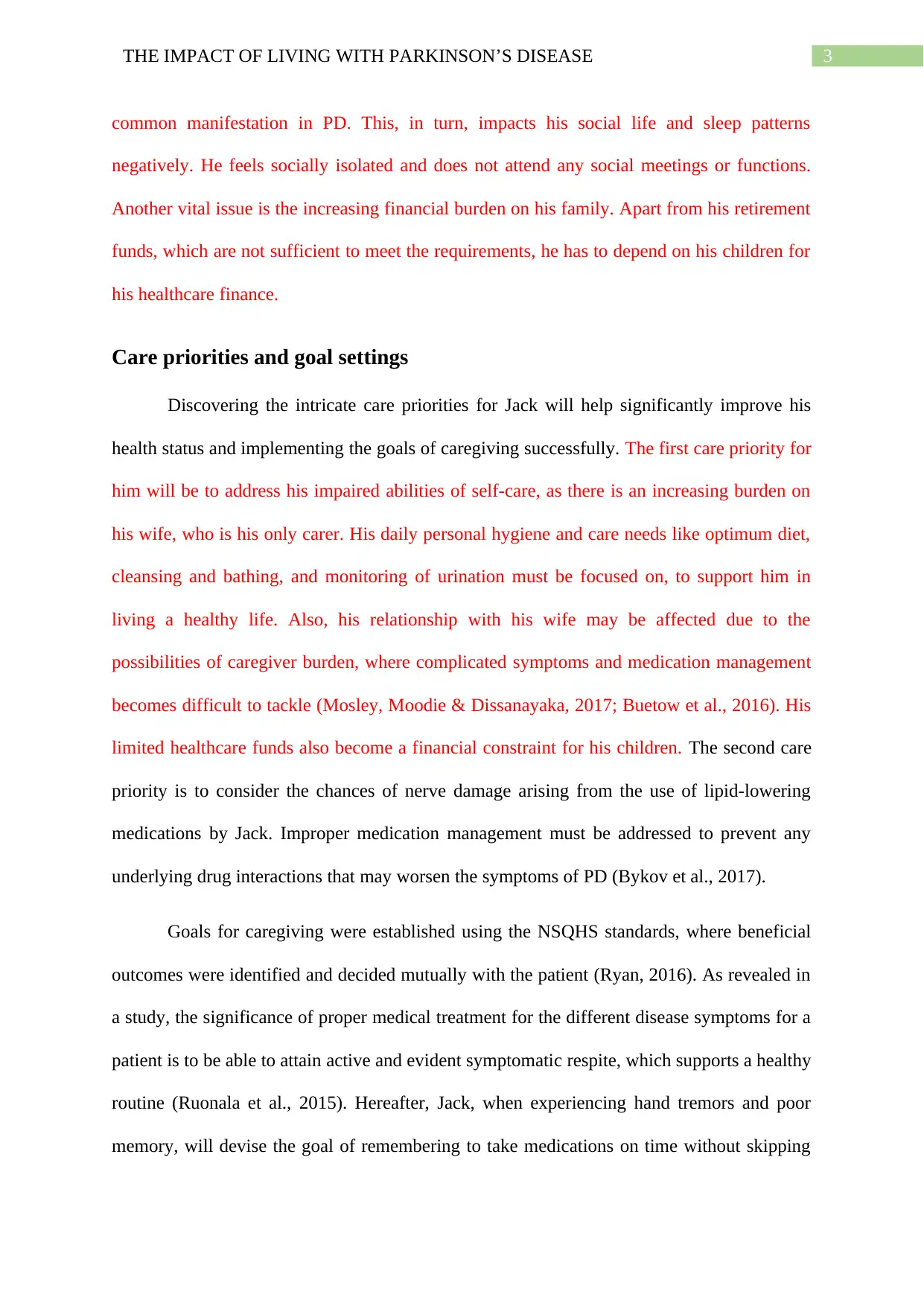
3THE IMPACT OF LIVING WITH PARKINSON’S DISEASE
common manifestation in PD. This, in turn, impacts his social life and sleep patterns
negatively. He feels socially isolated and does not attend any social meetings or functions.
Another vital issue is the increasing financial burden on his family. Apart from his retirement
funds, which are not sufficient to meet the requirements, he has to depend on his children for
his healthcare finance.
Care priorities and goal settings
Discovering the intricate care priorities for Jack will help significantly improve his
health status and implementing the goals of caregiving successfully. The first care priority for
him will be to address his impaired abilities of self-care, as there is an increasing burden on
his wife, who is his only carer. His daily personal hygiene and care needs like optimum diet,
cleansing and bathing, and monitoring of urination must be focused on, to support him in
living a healthy life. Also, his relationship with his wife may be affected due to the
possibilities of caregiver burden, where complicated symptoms and medication management
becomes difficult to tackle (Mosley, Moodie & Dissanayaka, 2017; Buetow et al., 2016). His
limited healthcare funds also become a financial constraint for his children. The second care
priority is to consider the chances of nerve damage arising from the use of lipid-lowering
medications by Jack. Improper medication management must be addressed to prevent any
underlying drug interactions that may worsen the symptoms of PD (Bykov et al., 2017).
Goals for caregiving were established using the NSQHS standards, where beneficial
outcomes were identified and decided mutually with the patient (Ryan, 2016). As revealed in
a study, the significance of proper medical treatment for the different disease symptoms for a
patient is to be able to attain active and evident symptomatic respite, which supports a healthy
routine (Ruonala et al., 2015). Hereafter, Jack, when experiencing hand tremors and poor
memory, will devise the goal of remembering to take medications on time without skipping
common manifestation in PD. This, in turn, impacts his social life and sleep patterns
negatively. He feels socially isolated and does not attend any social meetings or functions.
Another vital issue is the increasing financial burden on his family. Apart from his retirement
funds, which are not sufficient to meet the requirements, he has to depend on his children for
his healthcare finance.
Care priorities and goal settings
Discovering the intricate care priorities for Jack will help significantly improve his
health status and implementing the goals of caregiving successfully. The first care priority for
him will be to address his impaired abilities of self-care, as there is an increasing burden on
his wife, who is his only carer. His daily personal hygiene and care needs like optimum diet,
cleansing and bathing, and monitoring of urination must be focused on, to support him in
living a healthy life. Also, his relationship with his wife may be affected due to the
possibilities of caregiver burden, where complicated symptoms and medication management
becomes difficult to tackle (Mosley, Moodie & Dissanayaka, 2017; Buetow et al., 2016). His
limited healthcare funds also become a financial constraint for his children. The second care
priority is to consider the chances of nerve damage arising from the use of lipid-lowering
medications by Jack. Improper medication management must be addressed to prevent any
underlying drug interactions that may worsen the symptoms of PD (Bykov et al., 2017).
Goals for caregiving were established using the NSQHS standards, where beneficial
outcomes were identified and decided mutually with the patient (Ryan, 2016). As revealed in
a study, the significance of proper medical treatment for the different disease symptoms for a
patient is to be able to attain active and evident symptomatic respite, which supports a healthy
routine (Ruonala et al., 2015). Hereafter, Jack, when experiencing hand tremors and poor
memory, will devise the goal of remembering to take medications on time without skipping
Paraphrase This Document
Need a fresh take? Get an instant paraphrase of this document with our AI Paraphraser
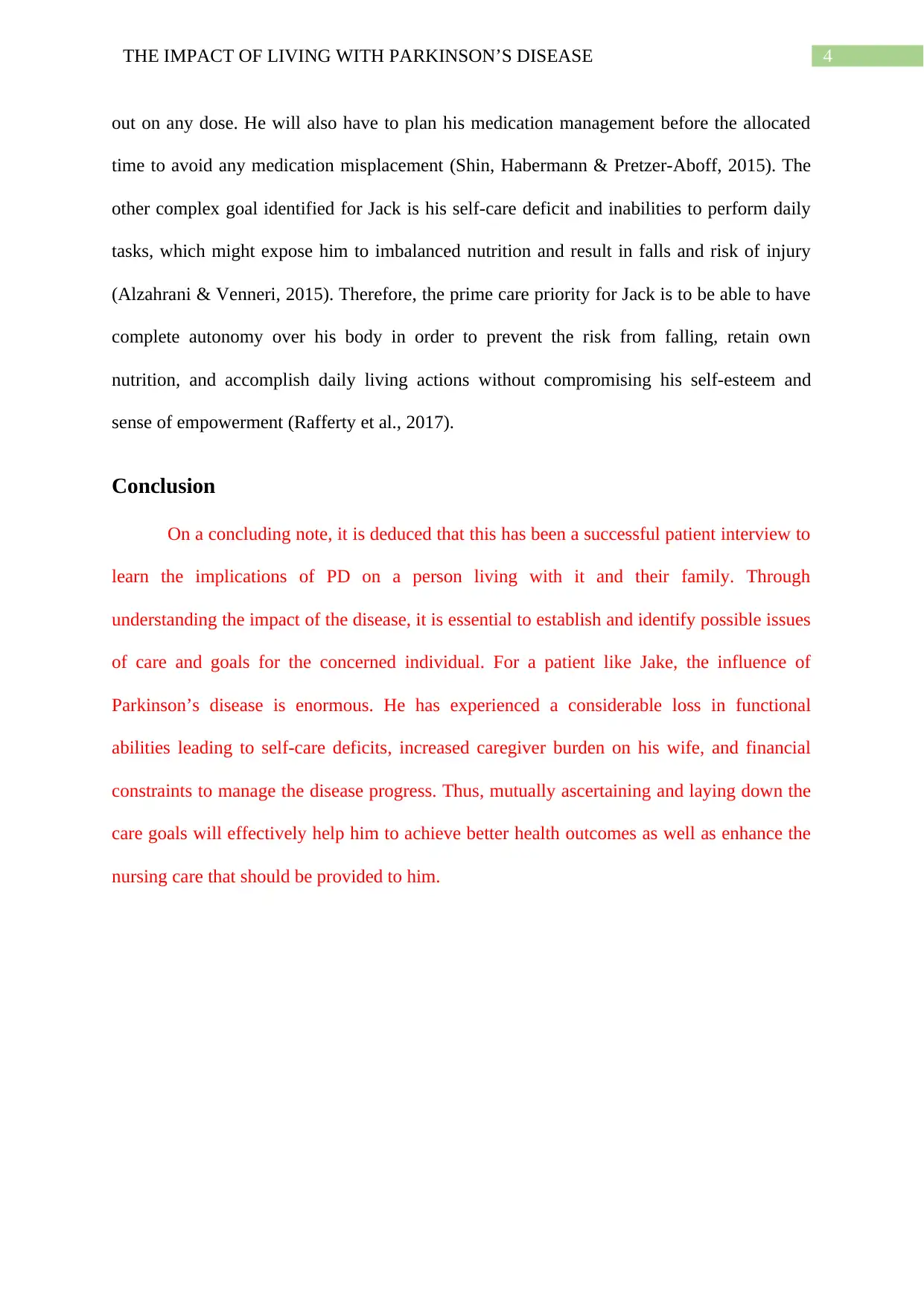
4THE IMPACT OF LIVING WITH PARKINSON’S DISEASE
out on any dose. He will also have to plan his medication management before the allocated
time to avoid any medication misplacement (Shin, Habermann & Pretzer-Aboff, 2015). The
other complex goal identified for Jack is his self-care deficit and inabilities to perform daily
tasks, which might expose him to imbalanced nutrition and result in falls and risk of injury
(Alzahrani & Venneri, 2015). Therefore, the prime care priority for Jack is to be able to have
complete autonomy over his body in order to prevent the risk from falling, retain own
nutrition, and accomplish daily living actions without compromising his self-esteem and
sense of empowerment (Rafferty et al., 2017).
Conclusion
On a concluding note, it is deduced that this has been a successful patient interview to
learn the implications of PD on a person living with it and their family. Through
understanding the impact of the disease, it is essential to establish and identify possible issues
of care and goals for the concerned individual. For a patient like Jake, the influence of
Parkinson’s disease is enormous. He has experienced a considerable loss in functional
abilities leading to self-care deficits, increased caregiver burden on his wife, and financial
constraints to manage the disease progress. Thus, mutually ascertaining and laying down the
care goals will effectively help him to achieve better health outcomes as well as enhance the
nursing care that should be provided to him.
out on any dose. He will also have to plan his medication management before the allocated
time to avoid any medication misplacement (Shin, Habermann & Pretzer-Aboff, 2015). The
other complex goal identified for Jack is his self-care deficit and inabilities to perform daily
tasks, which might expose him to imbalanced nutrition and result in falls and risk of injury
(Alzahrani & Venneri, 2015). Therefore, the prime care priority for Jack is to be able to have
complete autonomy over his body in order to prevent the risk from falling, retain own
nutrition, and accomplish daily living actions without compromising his self-esteem and
sense of empowerment (Rafferty et al., 2017).
Conclusion
On a concluding note, it is deduced that this has been a successful patient interview to
learn the implications of PD on a person living with it and their family. Through
understanding the impact of the disease, it is essential to establish and identify possible issues
of care and goals for the concerned individual. For a patient like Jake, the influence of
Parkinson’s disease is enormous. He has experienced a considerable loss in functional
abilities leading to self-care deficits, increased caregiver burden on his wife, and financial
constraints to manage the disease progress. Thus, mutually ascertaining and laying down the
care goals will effectively help him to achieve better health outcomes as well as enhance the
nursing care that should be provided to him.
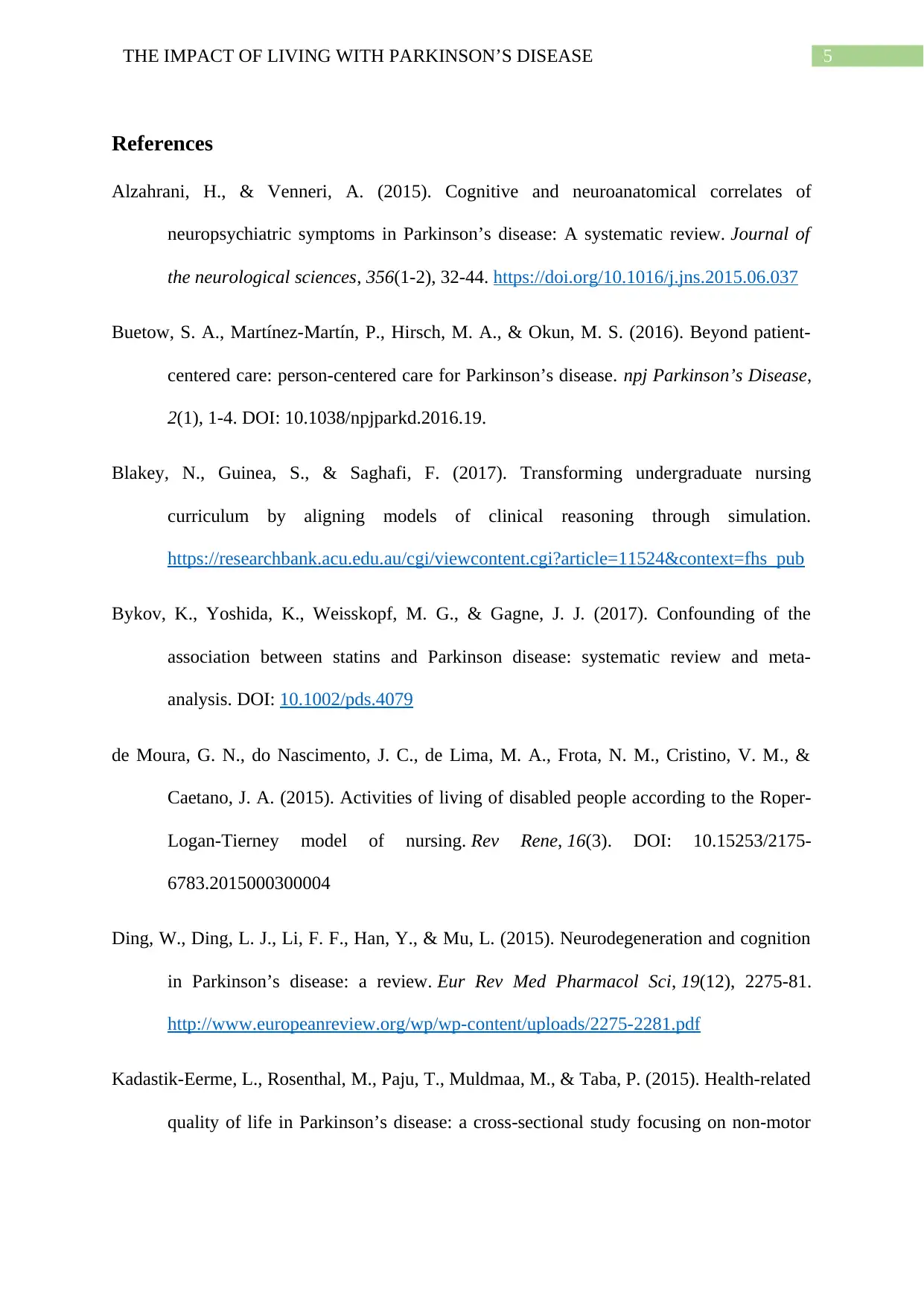
5THE IMPACT OF LIVING WITH PARKINSON’S DISEASE
References
Alzahrani, H., & Venneri, A. (2015). Cognitive and neuroanatomical correlates of
neuropsychiatric symptoms in Parkinson’s disease: A systematic review. Journal of
the neurological sciences, 356(1-2), 32-44. https://doi.org/10.1016/j.jns.2015.06.037
Buetow, S. A., Martínez-Martín, P., Hirsch, M. A., & Okun, M. S. (2016). Beyond patient-
centered care: person-centered care for Parkinson’s disease. npj Parkinson’s Disease,
2(1), 1-4. DOI: 10.1038/npjparkd.2016.19.
Blakey, N., Guinea, S., & Saghafi, F. (2017). Transforming undergraduate nursing
curriculum by aligning models of clinical reasoning through simulation.
https://researchbank.acu.edu.au/cgi/viewcontent.cgi?article=11524&context=fhs_pub
Bykov, K., Yoshida, K., Weisskopf, M. G., & Gagne, J. J. (2017). Confounding of the
association between statins and Parkinson disease: systematic review and meta-
analysis. DOI: 10.1002/pds.4079
de Moura, G. N., do Nascimento, J. C., de Lima, M. A., Frota, N. M., Cristino, V. M., &
Caetano, J. A. (2015). Activities of living of disabled people according to the Roper-
Logan-Tierney model of nursing. Rev Rene, 16(3). DOI: 10.15253/2175-
6783.2015000300004
Ding, W., Ding, L. J., Li, F. F., Han, Y., & Mu, L. (2015). Neurodegeneration and cognition
in Parkinson’s disease: a review. Eur Rev Med Pharmacol Sci, 19(12), 2275-81.
http://www.europeanreview.org/wp/wp-content/uploads/2275-2281.pdf
Kadastik-Eerme, L., Rosenthal, M., Paju, T., Muldmaa, M., & Taba, P. (2015). Health-related
quality of life in Parkinson’s disease: a cross-sectional study focusing on non-motor
References
Alzahrani, H., & Venneri, A. (2015). Cognitive and neuroanatomical correlates of
neuropsychiatric symptoms in Parkinson’s disease: A systematic review. Journal of
the neurological sciences, 356(1-2), 32-44. https://doi.org/10.1016/j.jns.2015.06.037
Buetow, S. A., Martínez-Martín, P., Hirsch, M. A., & Okun, M. S. (2016). Beyond patient-
centered care: person-centered care for Parkinson’s disease. npj Parkinson’s Disease,
2(1), 1-4. DOI: 10.1038/npjparkd.2016.19.
Blakey, N., Guinea, S., & Saghafi, F. (2017). Transforming undergraduate nursing
curriculum by aligning models of clinical reasoning through simulation.
https://researchbank.acu.edu.au/cgi/viewcontent.cgi?article=11524&context=fhs_pub
Bykov, K., Yoshida, K., Weisskopf, M. G., & Gagne, J. J. (2017). Confounding of the
association between statins and Parkinson disease: systematic review and meta-
analysis. DOI: 10.1002/pds.4079
de Moura, G. N., do Nascimento, J. C., de Lima, M. A., Frota, N. M., Cristino, V. M., &
Caetano, J. A. (2015). Activities of living of disabled people according to the Roper-
Logan-Tierney model of nursing. Rev Rene, 16(3). DOI: 10.15253/2175-
6783.2015000300004
Ding, W., Ding, L. J., Li, F. F., Han, Y., & Mu, L. (2015). Neurodegeneration and cognition
in Parkinson’s disease: a review. Eur Rev Med Pharmacol Sci, 19(12), 2275-81.
http://www.europeanreview.org/wp/wp-content/uploads/2275-2281.pdf
Kadastik-Eerme, L., Rosenthal, M., Paju, T., Muldmaa, M., & Taba, P. (2015). Health-related
quality of life in Parkinson’s disease: a cross-sectional study focusing on non-motor
⊘ This is a preview!⊘
Do you want full access?
Subscribe today to unlock all pages.

Trusted by 1+ million students worldwide
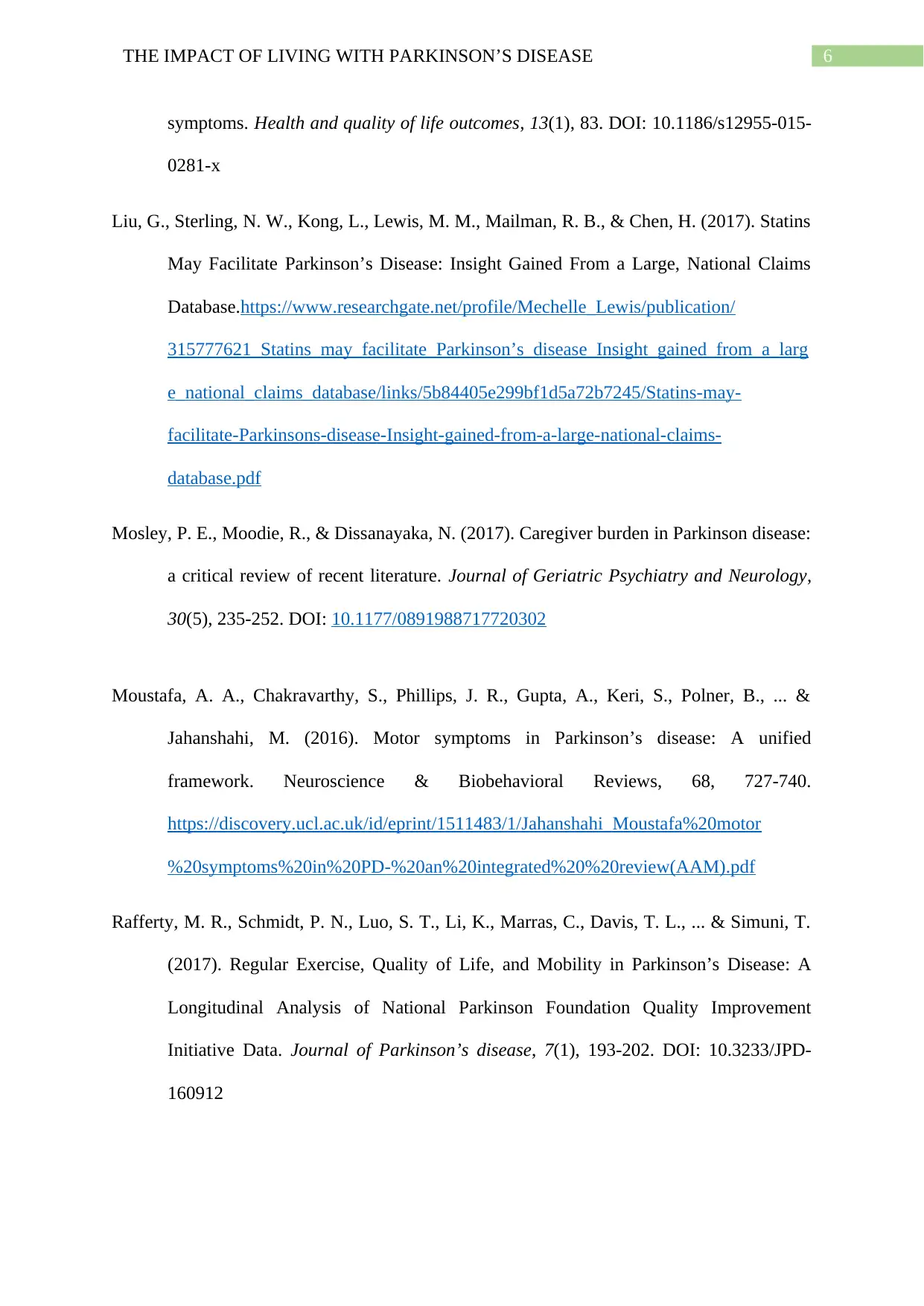
6THE IMPACT OF LIVING WITH PARKINSON’S DISEASE
symptoms. Health and quality of life outcomes, 13(1), 83. DOI: 10.1186/s12955-015-
0281-x
Liu, G., Sterling, N. W., Kong, L., Lewis, M. M., Mailman, R. B., & Chen, H. (2017). Statins
May Facilitate Parkinson’s Disease: Insight Gained From a Large, National Claims
Database.https://www.researchgate.net/profile/Mechelle_Lewis/publication/
315777621_Statins_may_facilitate_Parkinson’s_disease_Insight_gained_from_a_larg
e_national_claims_database/links/5b84405e299bf1d5a72b7245/Statins-may-
facilitate-Parkinsons-disease-Insight-gained-from-a-large-national-claims-
database.pdf
Mosley, P. E., Moodie, R., & Dissanayaka, N. (2017). Caregiver burden in Parkinson disease:
a critical review of recent literature. Journal of Geriatric Psychiatry and Neurology,
30(5), 235-252. DOI: 10.1177/0891988717720302
Moustafa, A. A., Chakravarthy, S., Phillips, J. R., Gupta, A., Keri, S., Polner, B., ... &
Jahanshahi, M. (2016). Motor symptoms in Parkinson’s disease: A unified
framework. Neuroscience & Biobehavioral Reviews, 68, 727-740.
https://discovery.ucl.ac.uk/id/eprint/1511483/1/Jahanshahi_Moustafa%20motor
%20symptoms%20in%20PD-%20an%20integrated%20%20review(AAM).pdf
Rafferty, M. R., Schmidt, P. N., Luo, S. T., Li, K., Marras, C., Davis, T. L., ... & Simuni, T.
(2017). Regular Exercise, Quality of Life, and Mobility in Parkinson’s Disease: A
Longitudinal Analysis of National Parkinson Foundation Quality Improvement
Initiative Data. Journal of Parkinson’s disease, 7(1), 193-202. DOI: 10.3233/JPD-
160912
symptoms. Health and quality of life outcomes, 13(1), 83. DOI: 10.1186/s12955-015-
0281-x
Liu, G., Sterling, N. W., Kong, L., Lewis, M. M., Mailman, R. B., & Chen, H. (2017). Statins
May Facilitate Parkinson’s Disease: Insight Gained From a Large, National Claims
Database.https://www.researchgate.net/profile/Mechelle_Lewis/publication/
315777621_Statins_may_facilitate_Parkinson’s_disease_Insight_gained_from_a_larg
e_national_claims_database/links/5b84405e299bf1d5a72b7245/Statins-may-
facilitate-Parkinsons-disease-Insight-gained-from-a-large-national-claims-
database.pdf
Mosley, P. E., Moodie, R., & Dissanayaka, N. (2017). Caregiver burden in Parkinson disease:
a critical review of recent literature. Journal of Geriatric Psychiatry and Neurology,
30(5), 235-252. DOI: 10.1177/0891988717720302
Moustafa, A. A., Chakravarthy, S., Phillips, J. R., Gupta, A., Keri, S., Polner, B., ... &
Jahanshahi, M. (2016). Motor symptoms in Parkinson’s disease: A unified
framework. Neuroscience & Biobehavioral Reviews, 68, 727-740.
https://discovery.ucl.ac.uk/id/eprint/1511483/1/Jahanshahi_Moustafa%20motor
%20symptoms%20in%20PD-%20an%20integrated%20%20review(AAM).pdf
Rafferty, M. R., Schmidt, P. N., Luo, S. T., Li, K., Marras, C., Davis, T. L., ... & Simuni, T.
(2017). Regular Exercise, Quality of Life, and Mobility in Parkinson’s Disease: A
Longitudinal Analysis of National Parkinson Foundation Quality Improvement
Initiative Data. Journal of Parkinson’s disease, 7(1), 193-202. DOI: 10.3233/JPD-
160912
Paraphrase This Document
Need a fresh take? Get an instant paraphrase of this document with our AI Paraphraser
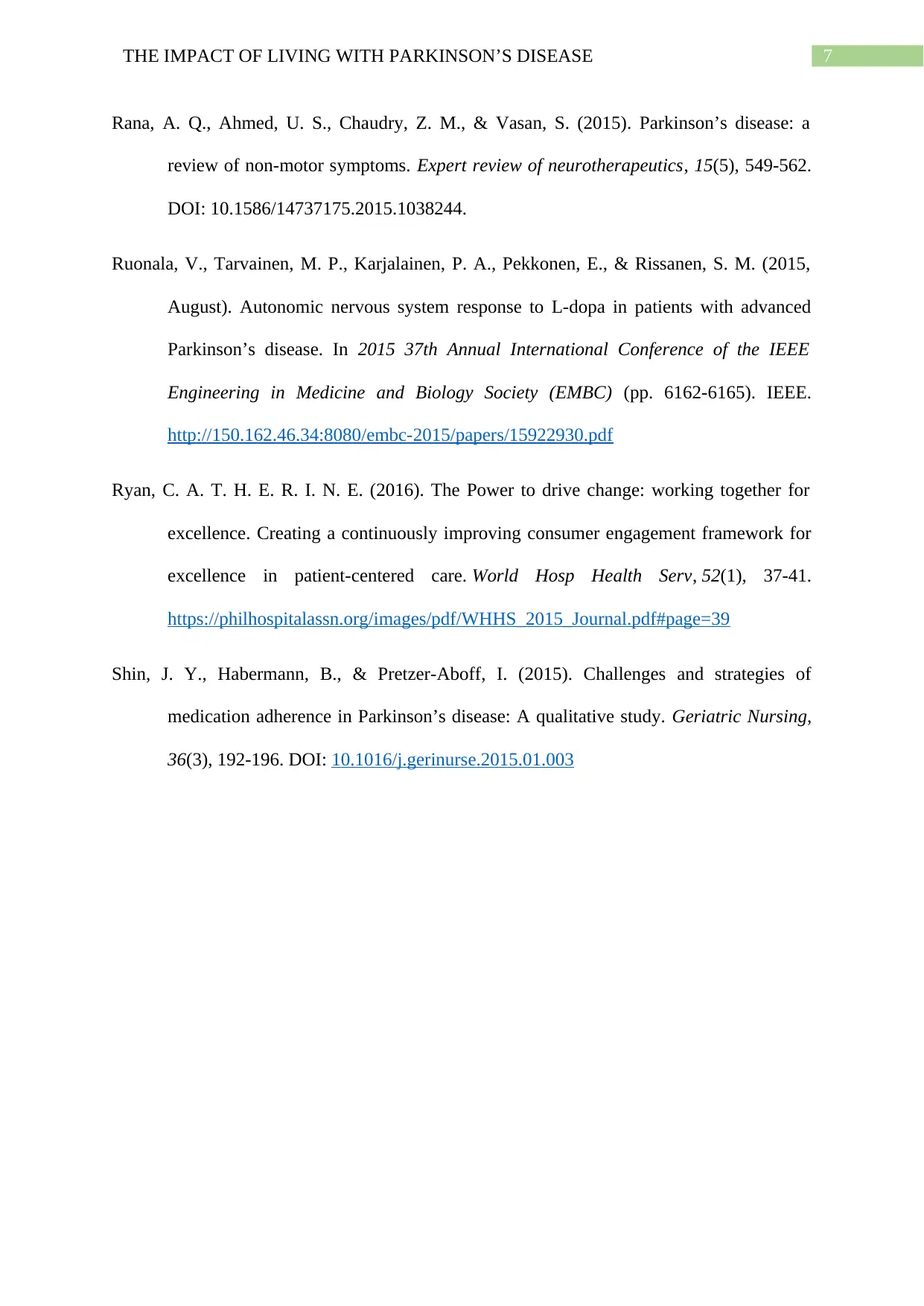
7THE IMPACT OF LIVING WITH PARKINSON’S DISEASE
Rana, A. Q., Ahmed, U. S., Chaudry, Z. M., & Vasan, S. (2015). Parkinson’s disease: a
review of non-motor symptoms. Expert review of neurotherapeutics, 15(5), 549-562.
DOI: 10.1586/14737175.2015.1038244.
Ruonala, V., Tarvainen, M. P., Karjalainen, P. A., Pekkonen, E., & Rissanen, S. M. (2015,
August). Autonomic nervous system response to L-dopa in patients with advanced
Parkinson’s disease. In 2015 37th Annual International Conference of the IEEE
Engineering in Medicine and Biology Society (EMBC) (pp. 6162-6165). IEEE.
http://150.162.46.34:8080/embc-2015/papers/15922930.pdf
Ryan, C. A. T. H. E. R. I. N. E. (2016). The Power to drive change: working together for
excellence. Creating a continuously improving consumer engagement framework for
excellence in patient-centered care. World Hosp Health Serv, 52(1), 37-41.
https://philhospitalassn.org/images/pdf/WHHS_2015_Journal.pdf#page=39
Shin, J. Y., Habermann, B., & Pretzer-Aboff, I. (2015). Challenges and strategies of
medication adherence in Parkinson’s disease: A qualitative study. Geriatric Nursing,
36(3), 192-196. DOI: 10.1016/j.gerinurse.2015.01.003
Rana, A. Q., Ahmed, U. S., Chaudry, Z. M., & Vasan, S. (2015). Parkinson’s disease: a
review of non-motor symptoms. Expert review of neurotherapeutics, 15(5), 549-562.
DOI: 10.1586/14737175.2015.1038244.
Ruonala, V., Tarvainen, M. P., Karjalainen, P. A., Pekkonen, E., & Rissanen, S. M. (2015,
August). Autonomic nervous system response to L-dopa in patients with advanced
Parkinson’s disease. In 2015 37th Annual International Conference of the IEEE
Engineering in Medicine and Biology Society (EMBC) (pp. 6162-6165). IEEE.
http://150.162.46.34:8080/embc-2015/papers/15922930.pdf
Ryan, C. A. T. H. E. R. I. N. E. (2016). The Power to drive change: working together for
excellence. Creating a continuously improving consumer engagement framework for
excellence in patient-centered care. World Hosp Health Serv, 52(1), 37-41.
https://philhospitalassn.org/images/pdf/WHHS_2015_Journal.pdf#page=39
Shin, J. Y., Habermann, B., & Pretzer-Aboff, I. (2015). Challenges and strategies of
medication adherence in Parkinson’s disease: A qualitative study. Geriatric Nursing,
36(3), 192-196. DOI: 10.1016/j.gerinurse.2015.01.003
1 out of 8
Related Documents
Your All-in-One AI-Powered Toolkit for Academic Success.
+13062052269
info@desklib.com
Available 24*7 on WhatsApp / Email
![[object Object]](/_next/static/media/star-bottom.7253800d.svg)
Unlock your academic potential
Copyright © 2020–2025 A2Z Services. All Rights Reserved. Developed and managed by ZUCOL.





